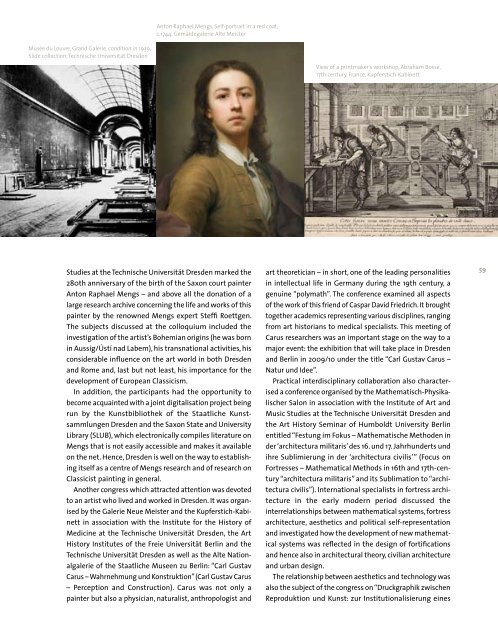2008 - Staatliche Kunstsammlungen Dresden
2008 - Staatliche Kunstsammlungen Dresden
2008 - Staatliche Kunstsammlungen Dresden
You also want an ePaper? Increase the reach of your titles
YUMPU automatically turns print PDFs into web optimized ePapers that Google loves.
Musée du Louvre, Grand Galerie, condition in 1939,<br />
Slide collection, Technische Universität <strong>Dresden</strong><br />
Anton Raphael Mengs, Self-portrait in a red coat,<br />
c.1744, Gemäldegalerie Alte Meister<br />
Studies at the Technische Universität <strong>Dresden</strong> marked the<br />
280th anniversary of the birth of the Saxon court painter<br />
Anton Raphael Mengs – and above all the donation of a<br />
large research archive concerning the life and works of this<br />
painter by the renowned Mengs expert Steffi Roettgen.<br />
The subjects discussed at the colloquium included the<br />
investigation of the artist’s Bohemian origins (he was born<br />
in Aussig/Ústí nad Labem), his transnational activities, his<br />
considerable influence on the art world in both <strong>Dresden</strong><br />
and Rome and, last but not least, his importance for the<br />
development of European Classicism.<br />
In addition, the participants had the opportunity to<br />
become acquainted with a joint digitalisation project being<br />
run by the Kunstbibliothek of the <strong>Staatliche</strong> <strong>Kunstsammlungen</strong><br />
<strong>Dresden</strong> and the Saxon State and University<br />
Library (SLUB), which electronically compiles literature on<br />
Mengs that is not easily accessible and makes it available<br />
on the net. Hence, <strong>Dresden</strong> is well on the way to establishing<br />
itself as a centre of Mengs research and of research on<br />
Classicist painting in general.<br />
Another congress which attracted attention was devoted<br />
to an artist who lived and worked in <strong>Dresden</strong>. It was organised<br />
by the Galerie Neue Meister and the Kupferstich-Kabinett<br />
in association with the Institute for the History of<br />
Medicine at the Technische Universität <strong>Dresden</strong>, the Art<br />
History Institutes of the Freie Universität Berlin and the<br />
Technische Universität <strong>Dresden</strong> as well as the Alte Nationalgalerie<br />
of the <strong>Staatliche</strong> Museen zu Berlin: “Carl Gustav<br />
Carus – Wahrnehmung und Konstruktion” (Carl Gustav Carus<br />
– Perception and Construction). Carus was not only a<br />
painter but also a physician, naturalist, anthropologist and<br />
View of a printmaker’s workshop, Abraham Bosse,<br />
17th century, France, Kupferstich-Kabinett<br />
art theoretician – in short, one of the leading personalities<br />
in intellectual life in Germany during the 19th century, a<br />
genuine “polymath”. The conference examined all aspects<br />
of the work of this friend of Caspar David Friedrich. It brought<br />
together academics representing various disciplines, ranging<br />
from art historians to medical specialists. This meeting of<br />
Carus researchers was an important stage on the way to a<br />
major event: the exhibition that will take place in <strong>Dresden</strong><br />
and Berlin in 2009/10 under the title “Carl Gustav Carus –<br />
Natur und Idee”.<br />
Practical interdisciplinary collaboration also characterised<br />
a conference organised by the Mathematisch-Physikalischer<br />
Salon in association with the Institute of Art and<br />
Music Studies at the Technische Universität <strong>Dresden</strong> and<br />
the Art History Seminar of Humboldt University Berlin<br />
entitled “Festung im Fokus – Mathematische Methoden in<br />
der ‘architectura militaris’ des 16. und 17. Jahrhunderts und<br />
ihre Sublimierung in der ‘architectura civilis’ ” (Focus on<br />
Fortresses – Mathematical Methods in 16th and 17th-century<br />
“architectura militaris” and its Sublimation to “architectura<br />
civilis”). International specialists in fortress architecture<br />
in the early modern period discussed the<br />
interrelationships between mathematical systems, fortress<br />
architecture, aesthetics and political self-representation<br />
and investigated how the development of new mathematical<br />
systems was reflected in the design of fortifications<br />
and hence also in architectural theory, civilian architecture<br />
and urban design.<br />
The relationship between aesthetics and technology was<br />
also the subject of the congress on “Druckgraphik zwischen<br />
Reproduktion und Kunst: zur Institutionalisierung eines<br />
5

















